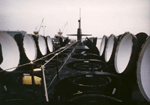|
Question:
The US is now considering building an
Anti Ballistic Missile (ABM) defense. Whether such a
"Star Wars" defense is even feasible is highly
controversial. But, if it worked, even imperfectly,
could it save money by replacing other weapon systems?
Answer:
President Bush's initiative on ABM makes little sense
as a defense against nuclear attacks by "rogue states,"
such as Libya, Iraq, Iran and North Korea— since, at present,
none of these countries have any deployed intercontinental
missiles, and, in the future, if it was ever successfully
deplored, they could resort to other delivery methods,
such as suitcases and airliners (which they do possess.)
But the Bush initiative lays the groundwork for a more
pragmatic ABM defense. "Rogue state" rhetoric not withstanding,
it also includes, what the President describes as "near
term" options for "capabilities to intercept missiles
... after they re-enter the atmosphere." Such interception
in the atmosphere, where decoys are no longer a problem
is a point defense. Point defenses are presently restricted
by the 1972 ABM treaty.
If carried out, it will require both deploying a new generation
of so-called PARs, Phased-Array Radars capable of tracking
incoming missiles and, in milliseconds, directing interceptor
towards them in milliseconds, and also breaking-out of
the 1972 treaty with the Soviet Union (which limits both
PAR radars and interceptors.)
Once the treaty is scrapped, the US is free to shield
its missile silo complexes with ABM point-defense systems.
How can this save money?
At present, the US relies exclusively on its underwater
missile platforms— the Trident submarines— to deter an
attack on its land-based missile and aircraft. These missiles
don't shoot down other missiles, but they provide a relatively-invulnerable
secondary force that could retaliate, after all our land-based
missiles and bombers were lost.. So they prevent an attack.
(The only nation with a capability to attack US land based
missiles is Russia.) But the back-up force is extremely
expensive. Each Trident II submarine, with 24 missiles,
costs between $3.5 and $4.5 billion dollars, and three
Tridents are necessary to keep one on station. The Trident
fleet, including its underwater communications and defense
systems, cost over $100 billion. And just maintaining
this submerged"shield" for the land-based forced costs
over $15 billion a year.
If an ABM point defense, supplemented by mid flight interception,
protected the US silo complexes to the exrent that they
were as likely to survive a surprise attack as the Trident
submarine platforms(which are not invulnerable with space
survellance), the Trident fleet could be retired, saving
$10 to $20 billion a year in operating costs
Collateral Question:
Would the US Navy, or its allies in Congress, ever accept
such an exchange of ABM for submerged deterrent?
|


